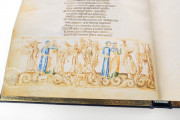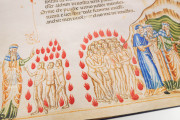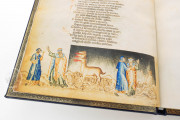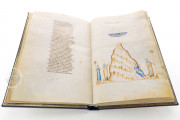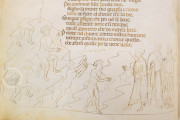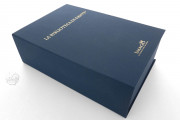The Add. 19587 Manuscript of the Divine Comedy—Dante Alighieri's Christian moralizing poem describing the three domains of the life to come—was copied and illuminated in Naples around 1370. The pre-eminent work of Italian literature, Dante's lengthy poem is an allegory of the soul's search for God cast in the form of a journey taken by the poet through the otherworld. The London manuscript is a significant work of fourteenth-century Neapolitan illumination, with its forty-eight completed bas-de-page drawings with washes of bright blue, red, green, beige, and occasional gold.
Dante's poem is divided into three sections treating hell (Inferno), purgatory—a place of punishment for sin—(Purgatorio), and heaven (Paradiso). Each comprises a series of episodes (cantos): thirty-three in each section, with one more at the opening for a total of 100.
Unfinished Illumination
The manuscript's miniatures are fully colored through Purgatorio, canto 21 (fol. 97v). The remaining miniatures in Purgatorio are unfinished, often only drawings without color, and no attempt was made to supply illumination to Paradiso.
The Poets Take Center Stage
Dante is led through most of his journey by the first-century BCE Roman poet Virgil. Toward the end of Purgatorio, Virgil is replaced as guide by Beatrice, Dante's ideal woman representing Christian grace. In the illustrations in Add. 19587, Dante appears in every scene. He and Virgil—consistently portrayed with a long beard and dressed in a cope of vair (bluish-gray and white squirrel fur)—are customarily larger than the other figures, emphasizing the poet's pilgrimage rather than the individual episodes he witnesses.
The Humble and the Proud
The illumination for Purgatorio, canto 7, the first terrace of purgatory, is rich in allusions (fol. 77r). Three episodes understood to represent humility take up most of the composition: the Annunciation to the Virgin, the Old Testament episode of Michal observing King David dancing before the Ark of the Covenant, and a poor widow petitioning the Roman emperor Trajan. At the right and extending up the outer margin of the page, Virgil directs Dante's attention to three proud men, shown naked and bearing huge boulders on their backs.
In the Florentine Tradition
The miniatures in Add. 19587 partake of the literal trend in illustrating the poem, and the illustrations of the early Neapolitan Oratoriana Manuscript probably served as indirect models. This literal trend has its ultimate roots in the Florentine tradition.
Terza Rima Articulated
Most of the text is written in Gothic Rotunda by a single scribe in long lines (a single column), with the first majuscule of each tercet set into the left margin. An extensive Latin-language rubric in red and a gold initial on a colored ground opens each canto. A second, less able scribe wrote seventeen pages (presumably substitutions). The decorated initials on these pages have light blue grounds.
Coats of Arms and Family Notes
An unidentified coat of arms appears in the border of the opening of Purgatorio (fol. 61r), perhaps that of the manuscript's original owner. The book was once owned by the Monforte family, Counts of Biseglia; family births and deaths in the fifteenth century are recorded on the manuscript's last page (fol. 177v). Edward Craven Hawtrey (1789-1862) owned the book before it was acquired by the British Museum in 1853. The Western manuscript collection of the British Museum was transferred to the British Library in 1973.
We have 1 facsimile edition of the manuscript "Divine Comedy - Add. 19587 Manuscript": La Divina Commedia Add. Ms. 19587 facsimile edition, published by Imago, 2022
Request Info / Price



